
Discovery of the M31 [OIII] emission arc
Recently, a major discovery by an international team of amateur astronomers and scientists has become a huge online hit, and this new discovery is just located in one of the

Hello William, thanks for accepting our interview invitation. Congratulations for winning ASIWEEK competition in week #50 2022.
Hello my name is William PELLISSARD, I am 53 years old and I live in Paris in the 13th arrondissement of Paris and I practice planetary astrophotography from a loggia on the 15th floor of my building.
 Me with my equipment
Me with my equipmentI was very quickly interested in astronomy from a very young age and as a teenager, I started to practice astrophotography which was silver halide at the time. I stopped practicing this hobby for about fifteen years. But around 2010, discovering the incredible results of amateurs with modern technics, I decided to practice planetary astrophotography.
I use a Skyvision 350 MT cassegrain astrograph at F/D 20 that’s why I only use certain cameras to have a suitable sampling. The primary mirror is made of Zerodur and the central obstruction is 24%. The mirrors were polished by Mr. Michel Bonnin of the Skyvision company, certainly one of the best French glass pushers.
The mount is an Astrophysics 1200 GTO, it easily supports the 31 kg of the optical tube. My optical assembly is the following, a robust electric crayford Optec without backlash with visualization of the pitch, an ADC Pierro-Astro MKIII (since the planets have been very low in France for many years, for example Saturn at less than 30° current elevation) a recent Zwo electric filter wheel, before I had a manual model but which was too restrictive and an X-Y stage which allows me to recenter the camera on the optical center each time the ADC setting is changed, this allows me not to lose the collimation.
For shooting, an ASI290MM, ASI462MC, ASI294MM camera (only for the large lunar field or complete mosaic of the moon) and finally a 174MM for the lunar and solar. I also have a ASI224Mc but I no longer use it.

 ZWO Gear
ZWO GearAll my images have been taken for a few years on my loggia located on the 15th and last floor of my building, I am next to a large stadium and a few hundred meters from the ring road. I only have a small window to image due to the top of the building limiting me to about 51° elevation!
 Skyvision 350 MT cassegrain
Skyvision 350 MT cassegrain In Paris and its suburbs there are many clubs but I do not adhere to them.
The first renowned amateur astronomer who influenced me to embark on planetary astrophotography and undoubtedly Mr. Thierry Legault, I had the chance in the late 1990s to meet him and buy him a remarkable instrument, a maksutov-cassegrain intès-micro rumak of 250mm. I did not immediately launch into digital astrophotography, which at the time seemed out of reach and too technical, but I regularly followed his work.
Around 2011 I discovered the superb site of Mr. Christian Viladrich, I already knew his magnificent images at the time of film photography where he excelled, Christian does not hesitate to share his knowledge (shooting, optical diagrams, use of filters, etc.), I can say that it was one of those incredible images of Jupiter that launched me into the world of digital astrophotography!
My image of Jupiter was taken from my loggia, I try to go out whenever the weather allows it and I don’t hesitate to observe all night to be sure to have a correct seeing moment, by the way it’s hard to go back to work the next morning. I started by making the most precise collimation possible on a star located around 45° elevation to have the least possible turbulence (I generally add a red filter to limit it) then I come back to Jupiter to adjust the ADC, this automatically causes a displacement of the planet (movement of the prisms), I refocus with the X-Y stage so as not to lose the optical center. As for the development, I constantly make corrections with the help of the step counter (Optec).
That night, the turbulence was fluctuating but I felt it would be good from the start of the evening. I like to do several series with the film sequencer in Firecapture, about ten and it allows me to perform a derotation of images if the films are of equivalent quality. For more convenience the ZWO camera is connected to the ST4 port in autoguiding, it is very practical especially since I regularly move my telescope to protect it from the rain and the wind so the setting up station is not always optimal, with this connection I no longer have to worry about catch-ups, it’s really a very practical function.
So I used the ZWO ASI462MC, I try to balance gain and acquisition speed, I think you shouldn’t systematically set a speed that is too fast, the quality of the gain is also important. Here I have therefore used the reasonable gain of 240, I pay particular attention to the histogram which must be located at 80%. The image was taken at 31°15, most of my images are taken between 30° and 48° elevation due to my site setup, I have a very narrow viewing window. I use Firecapture software for shooting, Autostakkert for stacking, and the excellent French software from “Lucien” Astrosurface, a real Swiss army knife, Winjupos and photoshop for some retouching.
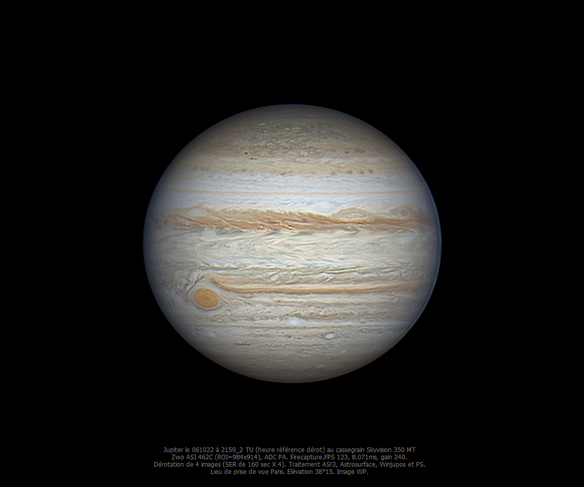 Target:Jupiter. Equipment: Skyvision 350 MT Cassegrain + ZWO ASI462MC + Astrophysics 1200 GTO mount
Target:Jupiter. Equipment: Skyvision 350 MT Cassegrain + ZWO ASI462MC + Astrophysics 1200 GTO mountI only practice the planetary imagery that I particularly like. In any case, it would be very difficult for me to perform DSO imaging from my site where light pollution is high. They are 2 different technics; I think deep sky requires more processing skills!
 Maksutov intès-Micro 250
Maksutov intès-Micro 250I practice astrophotography alone but very often I communicate by sms or Facebook messenger with my astrophotographer friends in the Paris suburbs and more particularly my close neighbor and friend (located 1 km from my home) Jean-Luc Dauvergne who is one of the best French astrophotographers, sometimes he motivates me to go out after a busy day at work. We talk a lot directly when we observe.
Nowadays we have many opportunities to share what we do with a large audience thanks to social networks. It’s always a pleasure for me to share what I know and what I’ve learned. We also have big meetings to meet people in France like Les Rencontres du Ciel et de l’Espace at La Cité Des Sciences. It happens once every 2 years and it’s this year, from November 11th to November 13th. It’s organized by the main magazine in French about astronomy: Ciel et Espace. I also used to share some of my images with the magazine, they have published a lot of them.
 Target: Saturn. Equipment: Skyvision 350mm F/20 Cassegrain + ZWO ASI462MC + Astro-Physics 1200GTO
Target: Saturn. Equipment: Skyvision 350mm F/20 Cassegrain + ZWO ASI462MC + Astro-Physics 1200GTOThe camera must have low readout noise, its pixel size must be between 2.9 and 4 with a high F/D instrument, it must be sensitive to short wavelength including UV.
The equivalent of the ZWO ASI462MC in monochrome version would be the ideal camera for practicing RGB to exploit the full potential of the optical tube when the conditions are excellent! IMX 2210 could be that one, it would be a pleasure to make a try if you already have some available. Ciel et Espace is also interested. A USB3 version of this camera could be very interesting for bigger telescopes.

Recently, a major discovery by an international team of amateur astronomers and scientists has become a huge online hit, and this new discovery is just located in one of the
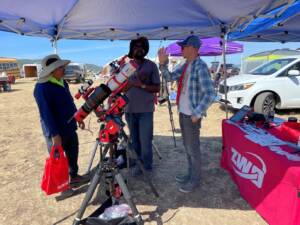
From June 25th to June 29th, under the pristine, dark skies of Northern California, nearly 500 stargazers, astrophotographers, and cosmic dreamers gathered for the Golden State Star Party (GSSP)—a celebration
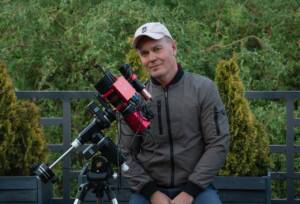
“Ever since I was a kid, I’ve been fascinated by the universe.”“I wouldn’t say it has changed me fundamentally, but it’s definitely become an important part of my life.”That simple
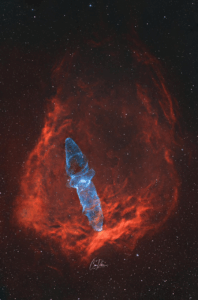
To most people, this might just look like a pretty picture. But to astrophotographer Cem Diken, it’s the result of three years of chasing a nearly invisible ghost in the

I was born in Guadalajara, I’m 38 years old, a musician, communications and electronics engineer, and president of the Guadalajara Astronomical Society A.C. since 2020. First Contact with Astronomy Since
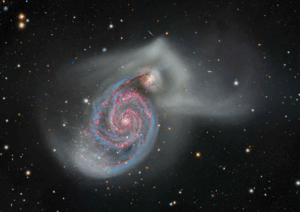
This stunning collaborative project comes from astrophotographers Alex Linde and Thomas Hansson, who joined forces across borders to photograph the Whirlpool Galaxy from Sweden, Poland, and Texas, USA. Thomas traveled across